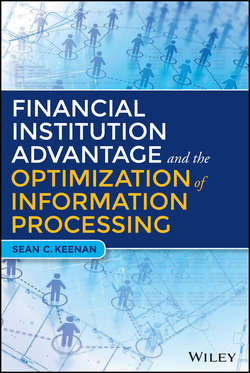Financial Institution Advantage and the Optimization of Information Processing

Реклама. ООО «ЛитРес», ИНН: 7719571260.
Оглавление
Keenan Sean C.. Financial Institution Advantage and the Optimization of Information Processing
Wiley & Sas Business Series
Introduction
Acknowledgments
Chapter 1. Financial Institutions as Information Processors
Financial Institutions' RAISON D'ÊTRE
Cultural Issues
IT Literacy and the Spreadsheet Deluge
Other Challenges to Establishing an IT-Savvy Culture
Chapter 2. Strategic Hardware and Software Management
Overview
An Integrated Data Architecture
Information Processing Efficiency as an Institutional Objective
A Digression on Unstructured Data
Chapter 3. Data, Models, and Information
Model Risk Mania
Definitions and Epistemology
Data Quality
Models and Their Role
Regulatory Regimes and Guidance
Chapter 4. Model Risk Measurement
Three Phases of Model Management
Model Governance
Defining Model Risk
Objectifying the Downside
Model Risk Attribution: An Information Entropy Approach
Chapter 5. The Return on Analytic Assets
Measuring the Productivity of Models
Complementarity of Data Inflow with Information Processing
A Digression on Price Taking
Chapter 6. Data Risk Measurement
Strategic Data Acquisition
The Information Conversion Rate
Other Approaches for Data Risk Assessment
Chapter 7. A Higher Level of Integration
Alternate Views of Integration
Identifying Key Information Cycles
An Integrated Physical View
Multidimensional Information Asset Management
Chapter 8. A Strategy for Optimizing the Information Processing Complex
Evaluation
A Path toward Improvement
Chapter 9. Case Studies
The Pricing of Automobile Insurance
Moody's KMV
The London Whale
The Mortgage-Backed Securities Disaster
The Value of Annuities
Chapter 10. Conclusions
References
About the Author
index
WILEY END USER LICENSE AGREEMENT
Отрывок из книги
At its most basic level, a financial institution is composed of four things: a brand, a collection of personnel, some physical assets, and analytic (information) assets. The last category includes things like data, data processing capabilities, statistical models of various kinds, and other analytic and reporting capabilities. This categorical breakdown is simplistic, and not exactly clean. For example, there is an overlap between physical assets and data processing capabilities: Are the computers themselves physical assets or information assets? Overlap also exists between personnel and analytic methods: Does a buy or sell decision stem from an analytic method or from a person who makes buy and sell decisions? In spite of this lack of clarity, using this categorization – even in its most simplistic form – can help to frame the crucial underlying competitive issues facing financial institutions today. These issues can be summarized as follows:
1. If you have a strong brand, great, try to preserve it. If not, try to build one. But how?
.....
This book seeks to provide context, as well as analytic and anecdotal support, for the simple characterization described above – that to be more successful and more competitive, financial institutions need to focus on information processing as the core competency. It seeks to provide some organization and definitions of terms and ideas embedded in the concept of management of information assets, primarily surrounding data and information processing and statistical modeling. The goal of this exercise is to make the relationship between firm organization around these functions and overall firm strategy and performance more stark. Finally, the book provides practical observations about how information assets can be actively and effectively managed to create competitive advantage and improved financial results. Toward the end of the book we survey some case studies that highlight some of the positive and less positive results that have stemmed from institutions either recognizing or failing to recognize the strategic importance of information processing capabilities.
• $13 billion: JPMorgan Chase (2013)
.....